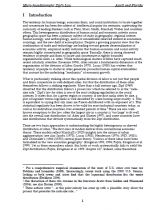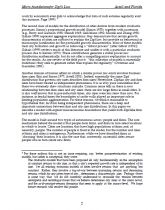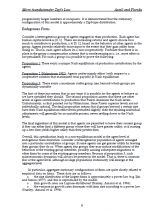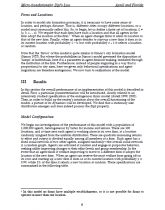Hledej
Zobraz:
Univerzity
Kategorie
Rozšířené vyhledávání
12 662
projektů
Emergent Cities: Micro-foundations of Zipf’s Law
| Přípona |
Typ referát |
Stažené 0 x |
| Velikost 0,3 MB |
Jazyk anglický |
ID projektu 2898 |
| Poslední úprava 27.03.2014 |
Zobrazeno 1 891 x |
Autor: eliseus |
 Sdílej na Facebooku
Sdílej na Facebooku |
||
| Detaily projektu | ||
- Cena:
2 Kreditů - kvalita:
88,8% -
Stáhni
- Přidej na srovnání
- Univerzita:Univerzita Tomáše Bati ve Zlíně
- Fakulta:Fakulta managementu a ekonomiky
- Kategorie:Ekonomika » Management
- Předmět:Management
- Studijní obor:-
- Ročník:-
- Formát:PDF dokument (.pdf)
- Rozsah A4:15 stran
The tendency for human beings, economic firms and social institutions to locate together
has been the subject of intellectual inquiry for centuries. People and firms are not spread
ubiquitously across the globe but have a powerful tendency to organize in well-defined
geographic units, cities. First Auerbach (1913) and then Zipf (1941; 1949) observed a
striking regularity in this process, noting the distribution in cities is highly skewed and
follows a simple “rank-size rule” (Zipf’s law). Despite considerable research on these
issues, there does not as exist an explanation for Zipf’s law based on behaviorallycredible
micro-foundations. This article offers such a model, using the fact that business
firms also have Zipf distributed sizes. The basic model is simple: people form together in
firms, and firms co-locate. The agents in the model have heterogeneous abilities, exhibit
bounded rationality, and interact directly with one another out of equilibrium in team
production environments. Each agent is part of a firm and each firm has a spatial
location. Agents periodically search for positions in other firms that would give them
higher payoffs. Agents can also start-up new firms, at either their current location or a
new location. Over time the movement of individual agents across firms combines with
the movement of firms across locations to yield clusters of agents and firms. From these
basic micro-foundations the model reproduces, under a wide range of conditions, a
distribution of cities that follows Zipf’s law. This model constitutes the first
behaviorally-plausible, microscopic explanation of the city size distribution, on the one
hand, and the mutual existence of Zipfian firm and city sizes on the other.
has been the subject of intellectual inquiry for centuries. People and firms are not spread
ubiquitously across the globe but have a powerful tendency to organize in well-defined
geographic units, cities. First Auerbach (1913) and then Zipf (1941; 1949) observed a
striking regularity in this process, noting the distribution in cities is highly skewed and
follows a simple “rank-size rule” (Zipf’s law). Despite considerable research on these
issues, there does not as exist an explanation for Zipf’s law based on behaviorallycredible
micro-foundations. This article offers such a model, using the fact that business
firms also have Zipf distributed sizes. The basic model is simple: people form together in
firms, and firms co-locate. The agents in the model have heterogeneous abilities, exhibit
bounded rationality, and interact directly with one another out of equilibrium in team
production environments. Each agent is part of a firm and each firm has a spatial
location. Agents periodically search for positions in other firms that would give them
higher payoffs. Agents can also start-up new firms, at either their current location or a
new location. Over time the movement of individual agents across firms combines with
the movement of firms across locations to yield clusters of agents and firms. From these
basic micro-foundations the model reproduces, under a wide range of conditions, a
distribution of cities that follows Zipf’s law. This model constitutes the first
behaviorally-plausible, microscopic explanation of the city size distribution, on the one
hand, and the mutual existence of Zipfian firm and city sizes on the other.
Klíčová slova:
economic
region
enviroments
existence
locations
Obsah:
- I Introduction
II Model Structure
III Results
Model Configuration
Model Dynamics
Model Size Distributions
Alternative Model Specifications
Effect of a growing population
IV Conclusions
References
Zdroje:
- Ades, A. F. and E. L. Glaeser (1997). "Trade and Circuses: Explalining Urban Giants."
- Quarterly Journal of Economics 110(1): 195-227.
- Auerbach, F. (1913). "Das gesetz der bevolkerungskonzentration." P e termanns
- Geographische M itteilungen 59: 74-76.
- Axtell, R. L. (1999). The Emergence of Firms in a Population of Agents: Local Increasing
- Returns, Unstable Nash Equilibria, and Power Law Size Distributions. W o rking
- paper . Santa Fe, N.M., Santa Fe Institute.
- Axtell, R. L. (2001). "Zipf Distribution of U.S. Firm Sizes." S cienc e 293(5536): 1818-20.
- Axtell, R. L. (2002). Non-Cooperative Dynamics of Multi-Agent Teams. P r oceedings of the
- First International Joint Conference on Autonomous Agents and M ultiagen t
- Systems . C. Castelfranchi and W. L. Johnson. Bologna, Italy, ACM Press. Part 3:
- 1082-1089.
- Basu, S. and J. G. Fernald (1997). "Returns to Scale in U.S. Manufacturing: Estimaes and
- Implications." J o urnal of Political Economy 105: 249-283.
- Batten, D. F. (2000). D i scovering Artificial Economics: How Agents Learn and Economies
- Evolve . Boulder, Colorado, Westview Press.
- Berry, B. J. L. and W. L. Garrison (1958). "Alternative explanations of urban rank-size
- relationships." A nnals of the Association of American Geographer s 48: 83-91.
- Brown, C. and J. Medoff (1989). "The Employer Size-Wage Effect." J o urnal of Political
- Economy 97: 1027-1059.
- Christaller, W. (1966 [1933]). C entral Places in Southern Germany . London, Prentice Hall.
- Dobkins, L. H. and Y. M. Ioannides (1998). Evolution of the U.S. City Size Distribution. T h e
- Economics of Cities . J.-M. Huriot and J.-F. Thisse. New York, N.Y., Cambridge
- University Press.



